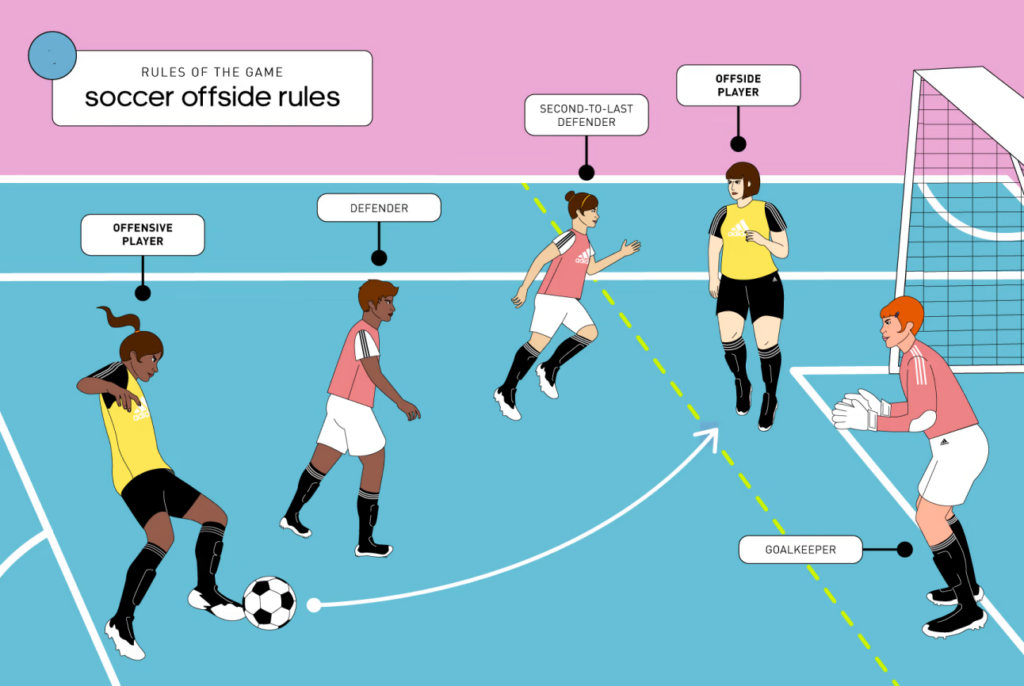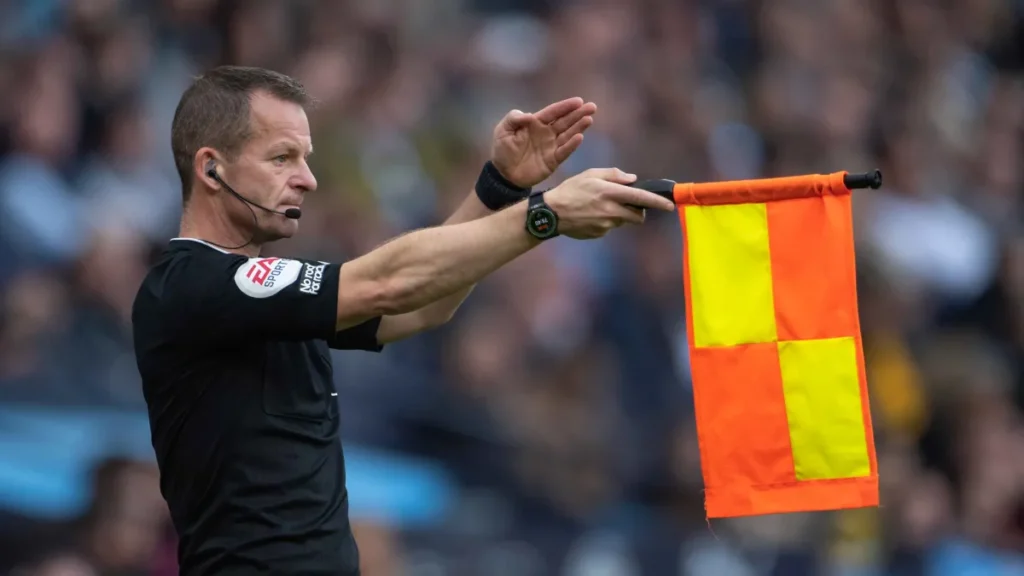If you want to enhance your enjoyment and analysis of football matches, read on to learn all about offside football and the offside rule in football.
What is Offside in Football? A Simple Guide to Understanding the Controversial Rule
Offside rule in football is one of the most contentious laws in the game. It can completely change the outcome of a match and has been the subject of much debate among football fans, players, and officials alike. In this article, we will provide a comprehensive guide to the offside rule in football, explaining its origins, purpose, and different aspects in detail.
Whether you are a seasoned football enthusiast, football betting expert or a novice who wants to learn more about the game, this guide will provide you with a clear and concise understanding of the offside rule. We’ll cover the definition of offside position, when a player is considered offside, different types of offside offenses, penalties and disciplinary actions, and controversial aspects of the rule.
Table of Contents
- 1 Origin and Purpose of the Offside Rule
- 2 Definition of Offside Position
- 3 When is a Player Offside?
- 4 Offside Offenses and Interference
- 5 No Offside Offense Situations
- 6 Penalties and Discipline
- 7 Offside Position vs. Offside Offense
- 8 Controversial Aspects
- 9 Conclusion
- 10 FAQ
- 10.1 What is the offside rule in football?
- 10.2 How does the offside rule contribute to the fairness of the game?
- 10.3 What constitutes an offside position?
- 10.4 When is a player considered offside?
- 10.5 What are some examples of offside offenses?
- 10.6 Are there any situations where there is no offside offense?
- 10.7 What are the penalties for offside offenses?
- 10.8 What is the difference between being in an offside position and committing an offside offense?
- 10.9 Are there any controversial aspects of the offside rule?
Origin and Purpose of the Offside Rule
The offside rule has been an essential element of the game of football since its inception. The history of the offside law can be traced back to the early days of football, to the first set of rules formulated by the Football Association (FA) in England in 1863. The offside rule was included in the original set of laws, primarily as a means of preventing goal-hanging and encouraging a more strategic style of play.
The initial offside rule stipulated that a player was offside if they were in front of the ball when it was played, and only the opposing team’s goalkeeper or the last defender stood between them and the goal line. This rule was modified in 1925 to the current second last opponent criteria, which became the standard for most countries.
The purpose of the offside rule is to ensure that attacking players do not gain an unfair advantage by positioning themselves closer to the opponent’s goal than the defending team’s players. This prevents teams from simply launching long balls to players waiting near the opponent’s goal line, keeping the game fair and balanced.
Definition of Offside Position
In football, a player is considered to be in an offside position if they are closer to the opponent’s goal line than both the ball and the second last opponent. A player is only in an offside position if they are actively involved in the play.
Being in an offside position alone does not result in a foul, but if the player involved in the offside position “gains an advantage” by playing the ball, an offside offense occurs. The following are the criteria for determining whether a player is in an offside position:
| Criteria | Explanation |
|---|---|
| The player’s position | The player must be closer to the opponent’s goal line than both the ball and the second last opponent |
| The second last opponent’s position | The second last opponent can be a defender, goalkeeper, or any other player who is not the attacking team’s goalkeeper or last defender |
| The ball’s position | The ball must be closer to the opponent’s goal line than both the player in the offside position and the second last opponent |
It’s important to note that if a player is in an offside position, it doesn’t necessarily mean they’ve committed an offside offense. The player is not considered to be involved in active play if they have not touched the ball or interfered with an opponent.
For example, a player who is in an offside position but has not touched the ball is not considered to have committed an offside offense. However, if the player in the offside position is blocking the goalkeeper’s line of vision, then the player is committing an offside offense.

When is a Player Offside?
In football, a player is considered offside if they are in an offside position at the moment the ball is played or touched by a teammate. However, being in an offside position alone is not enough to be considered offside; the player must also be involved in active play and be ahead of the second last opponent.
An offside position is when a player is nearer to the opponents’ goal line than both the ball and the second last opponent.
| Criteria | Explanation |
|---|---|
| Nearer to the goal line | The player is ahead in relation to the ball and the second last opponent. |
| Involved in active play | The player is either interfering with play or interfering with an opponent. |
| Ahead of the second last opponent | The player is in front of the second last opponent when the ball is played by their teammate. |
A player is deemed to be interfering with play if they touch or play the ball that has been passed or touched by a teammate. Furthermore, a player is considered to interfere with an opponent if they prevent an opponent from playing the ball by obstructing their line of vision, challenging them for the ball, or making a gesture or movement that deceives or distracts the opponent.
It’s important to note that a player cannot be offside if they receive the ball directly from a goal kick, a throw-in, or a corner kick. Additionally, a player cannot be offside if they are in their own half of the field or if they don’t participate in the play.
Offside Offenses and Interference
Understanding the offside rule in football is crucial for players and fans alike. However, it is equally important to comprehend the various types of offside offenses that can occur during a match. These offenses can result in a free kick or even a yellow card for the offending player.
An offside offense occurs when a player in an offside position becomes involved in active play by:
- Interfering with an opponent
- Gaining an advantage by being in that position
- Playing a ball that rebounds off a post or crossbar
- Playing a ball that rebounds off an opponent
The most common offside offense is interfering with an opponent. This occurs when a player in an offside position:
- Prevents an opponent from playing or being able to play the ball by clearly obstructing the opponent’s line of vision
- Challenges an opponent for the ball
- Makes any action that deceives or distracts an opponent
It is important to note that a player cannot commit an offside offense if they receive the ball directly from a goal kick, corner kick, or throw-in. Additionally, a player in an offside position who receives the ball from a teammate who is not in an offside position does not commit an offside offense.
Interfering with an opponent is a subjective call, and the decision made by the referee can often be contentious. However, if an opponent is clearly obstructed or distracted by an offside player, the referee is likely to award a free kick to the opposing team.

No Offside Offense Situations
While being in an offside position can lead to an offside offense, there are situations in which a player in an offside position is not penalized. These situations occur when:
- The player is not involved in active play
- The ball is played by a teammate
- The ball is played by an opponent
- The player is on their half of the field or level with the second-last opponent or the ball
In these situations, the player in an offside position is not interfering with play and, therefore, not committing an offside offense. The ball must still be on the opponent’s half of the field, and the player must not have gained an advantage by being in the offside position.
It’s important to note that if a player in an offside position becomes involved in active play, such as by interfering with an opponent or gaining an advantage, an offside offense occurs, and the player will be penalized accordingly.
Example:
| Scenario | Call |
|---|---|
| A player is in an offside position but does not interfere with play, and the ball is played by an opponent. | No offside call |
| A player is in an offside position and interferes with an opponent, preventing them from playing the ball. | Offside offense, indirect free kick awarded to the opposing team |
| A player is in an offside position but does not become involved in active play, and the ball is played by a teammate. | No offside call |
Penalties and Discipline
Offside offenses can result in various penalties and disciplinary actions, depending on the specific circumstances of the situation.
Indirect Free Kick
If a player is deemed to be in an offside position and involved in active play, the opposing team is awarded an indirect free kick. This kick must be taken from the spot where the offside offense occurred.
Direct Free Kick
If a player is in an offside position and interferes with an opponent, the opposing team is awarded a direct free kick. This kick is taken from the spot where the interference occurred.
Yellow Card
If a player continually commits offside offenses throughout a match, they may receive a yellow card from the referee as a warning.
Red Card
If a player commits a severe or intentional offside offense, such as deliberately interfering with an opponent or denying a clear goal-scoring opportunity, they may be shown a red card by the referee and sent off the field. This results in the player’s team having to play with one fewer player and potentially facing further disciplinary action after the match.

Offside Position vs. Offside Offense
Many people often confuse being in an offside position with committing an offside offense. However, it’s important to understand that the two are not the same thing.
A player is considered to be in an offside position if they are closer to the opponents’ goal line than both the ball and the last defending player. Being in an offside position does not automatically result in an offside offense.
| Offside player | Offside offense occurs |
|---|---|
| A player is in an offside position, but the ball is played to a teammate who is not in an offside position. | No offside offense occurs. |
| A player is in an offside position and becomes involved in active play by interfering with an opponent or gaining an advantage from being in that position. | An offside offense occurs. |
| A player is not in an offside position but becomes involved in active play by receiving the ball from a teammate who is in an offside position. | An offside offense occurs. |
As seen in the above table, a player can be in an offside position without committing an offside offense. On the other hand, a player can also commit an offside offense without being in an offside position.
It’s important to keep this distinction in mind when analyzing offside decisions. Just because a player is in an offside position doesn’t necessarily mean that they have committed an offside offense. Careful consideration of the specific circumstances of the play is crucial in making accurate judgments.
Controversial Aspects
The implementation of the offside rule in football has been a subject of controversy and debate for years. One of the most contentious aspects of the rule is the use of video assistant referees (VAR) to make offside decisions.
Videos of close offside calls have shown that even with the aid of technology, decisions can still be subjective and open to interpretation. Some argue that VAR disrupts the flow and spontaneity of the game, while others believe it is necessary for making fair and accurate decisions.
Despite the challenges of implementing VAR, the use of technology has led to more consistent and accurate offside decisions in major competitions, such as the Premier League and the Champions League.
Conclusion
In conclusion, understanding the offside rule is essential to fully appreciate the nuances of a football match. This rule has been in place since the early days of football, and its purpose is to ensure fairness and prevent undue advantage to one team over another.
Whether you’re a player, coach, or fan, a solid comprehension of this rule can enhance your experience of the game. It can also help you analyze the most exciting moments that happen throughout the match.
So the next time you watch a football match, keep the offside rule in mind. Knowing when a player is or isn’t in an offside position can help you understand the referee’s calls and anticipate the gameplay.
Understanding the offside rule will not only increase your appreciation for the game but also help you join the conversation on the most controversial calls. So, enjoy the game and keep offside football rules in mind!

FAQ
What is the offside rule in football?
The offside rule in football is a regulation that determines whether a player is in an offside position when the ball is played to them. If a player is in an offside position and involved in active play, they may be penalized.
How does the offside rule contribute to the fairness of the game?
The offside rule ensures that attacking players do not gain an unfair advantage by positioning themselves ahead of defenders. It promotes fairness by preventing goal-scoring opportunities that result from being in an offside position.
What constitutes an offside position?
A player is considered to be in an offside position if they are nearer to the opponents’ goal line than both the ball and the second last defender, excluding the goalkeeper. However, being in an offside position alone does not necessarily mean an offense has been committed.
When is a player considered offside?
A player is considered offside if they are in an offside position and involved in active play. This means they are interfering with an opponent or gaining an advantage from being in that position.
What are some examples of offside offenses?
Offside offenses include interfering with an opponent, gaining an advantage from being in an offside position, or playing the ball after rebounding off the goalpost or an opponent. These actions can result in a free kick for the opposing team.
Are there any situations where there is no offside offense?
Yes, there are situations where a player may be in an offside position but not commit an offense. If the player is not interfering with an opponent or gaining an advantage from their position when the ball is played to them, no offside offense occurs.
What are the penalties for offside offenses?
Offside offenses result in an indirect free kick for the opposing team from the place where the offense occurred. If a player repeatedly commits offside offenses, they may receive a yellow card for unsporting behavior or, in severe cases, a red card for persistent infringement of the rules.
What is the difference between being in an offside position and committing an offside offense?
Being in an offside position means a player is closer to the opponents’ goal line than both the ball and the second last defender. However, being in this position alone does not constitute an offense. An offense occurs when a player in an offside position interferes with an opponent or gains an advantage from their position.
Are there any controversial aspects of the offside rule?
Yes, the offside rule can be a source of controversy, especially regarding close offside calls. The introduction of video assistant referees (VAR) has aimed to assist in making accurate offside decisions, but contentious judgments continue to spark debates within the football community.

















